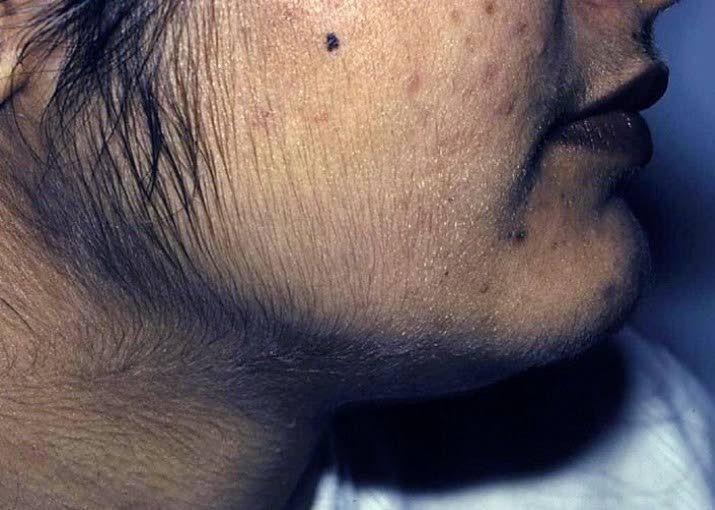Facial hair in females

Dr Maxwell Adeyemi
Adults have two types of hair: vellus hair (soft, fine, short, and colourless) and terminal hair (long, dark, and coarse). Women have vellus hair on their face, arms, chest, and back, with terminal hair limited to the armpits and pubic region. Men have terminal hairs all over their bodies because their androgen hormone levels are far higher than females (usually four-20 times higher).
Androgens are a type of sexual hormone. They aid in the initiation of puberty and play a role in reproductive health and body development. Androgens are produced by both sexes, but men produce more. The most common androgen is testosterone.
If a woman’s hair follicles are exposed to high androgen levels or become more sensitive to normal androgen levels, her soft, vellus hairs can transform into terminal hairs, a condition known as hirsutism.
What is hirsutism?
This is a condition in which a woman’s coarse body hair grows in a pattern similar to that of men. Increased amounts of soft hair are more indicative of non-hormonal causes of hair growth, which are more common in various ethnicities. Increased amounts of coarse and often dark hair, such as that seen in the pubic region, are more indicative of a hormonal cause of hair growth.
This is most common on the face, back, midline chest, lower abdomen, inner thigh, and buttocks. Arm hair can also darken, making the hair appear thicker. Extra hair growth caused by excess male hormones (Androgens), primarily testosterone, is common in hirsutism.
Androgens in women
Androgens are produced in the ovaries, adrenal glands, and fat cells in women. Women may produce too many or too few of these hormones. Androgen excess and deficiency disorders are among the most common hormonal disorders in women. Androgens play an important role in the hormonal cascade that initiates puberty in women, stimulating hair growth in the pubic and underarm areas.
These hormones also regulate the function of many organs, including the reproductive tract, bone, kidneys, liver, and muscle. Androgens are required for estrogen synthesis in adult women and have been shown to play an important role in bone loss prevention as well as sexual desire and satisfaction. Excess androgens can cause virilising effects such as acne, hirsutism (excess hair growth in inappropriate places such as the chin or upper lip), and hair thinning on the head (balding).
Symptoms of hirsutism
When high androgen levels cause hirsutism, other symptoms, known as virilisation, may develop over time. Virilisation symptoms could include:
* Deepening voice
* Balding
* Acne
* Decreased breast size
* Increased muscle mass
* Enlargement of the clitoris
Causes of hirsutism
Genetics.Women whose immediate family members experience symptoms of hirsutism are more likely to experience it themselves.
Polycystic ovary syndrome (PCOS). The most common ovarian cause of hirsutism is polycystic ovary syndrome (PCOS). The syndrome is characterised by irregular ovulation and, as a result, irregular menstrual cycles, increased hair growth or the presence of acne, and, in some cases, polycystic ovaries.
Cushing syndrome. Cushing’s syndrome, a rare disease, can also cause hirsutism. Cushing syndrome is caused by the adrenal glands producing too much cortisol. Although hirsutism is seen in cushing syndrome patients, high blood pressure, diabetes, muscle weakness, fatigue, red stretch marks, and obesity are all common signs and symptoms.
Congenital adrenal hyperplasia. This inherited condition is characterised by adrenal glands’ abnormal production of steroid hormones such as cortisol and androgen. The most common adrenal gland abnormality that can cause hirsutism is non-classical adrenal hyperplasia which causes the adrenal glands to overproduce androgens, like PCOS, is associated with irregular menstrual cycles.
Tumors. Rarely, an androgen-secreting tumour in the ovaries or adrenal glands can cause hirsutism.
Medications. Some medications can cause hirsutism. These include minoxidil, rogaine used to treat hair loss; danazol, which is used to treat women with endometriosis; testosterone treatments; and dehydroepiandrosterone (DHEA). If your partner uses topical products containing androgens, you can be affected as well, through skin-to-skin contact.
Risk factors
Several factors can influence your likelihood of developing hirsutism, including:
Family history. Several conditions that cause hirsutism, including congenital adrenal hyperplasia and polycystic ovary syndrome, run in families.

Ancestry. Women of Mediterranean, Middle-Eastern and South-Asian ancestry are more likely to have more body hair with no identifiable cause than are other women.
Obesity. Being obese causes increased androgen production, which can worsen hirsutism.
Hirsutism can be emotionally distressing. Some women feel self-conscious about having unwanted hair. Some develop depression. Also, although hirsutism doesn't cause physical complications, the underlying cause of a hormonal imbalance can.
If you have hirsutism and irregular periods, you might have polycystic ovary syndrome, which can inhibit fertility. Women who take certain medications to treat hirsutism should avoid pregnancy because of the risk of birth defects.
Treatment
Treatment of hirsutism with no sign of endocrine disorder is not necessary. For women who do need or seek treatment, it may involve treating any underlying disorder, developing a self-care routine for unwanted hair, and trying various therapies and medications.
Treatment options include:
Oral contraceptives. Birth control pills or other hormonal contraceptives, which contain estrogen and progestin, treat hirsutism caused by androgen production.
Anti-androgens. These types of drugs block androgens from attaching to their receptors in your body. They're sometimes prescribed after six months on oral contraceptives if the oral contraceptives aren't effective enough.
Topical cream. Specifically, for excessive facial hair in women. It's applied directly to the affected area of your face twice a day. It helps slow new hair growth but doesn't get rid of existing hair. It can be used with laser therapy to enhance the response.
Laser therapy. A beam of highly concentrated light (laser) is passed over your skin to damage hair follicles and prevent hair from growing.
Electrolysis. This treatment involves inserting a tiny needle into each hair follicle. The needle emits a pulse of electric current to damage and eventually destroy the follicle.
Plucking. Plucking is a good method to remove a few stray hairs, but is not useful for removing a large area of hair. Plucked hair usually regrows. This hair removal method may be done with tweezers, thin threads (threading) or other devices designed for this purpose.
Shaving. Shaving is quick and inexpensive, but it needs to be repeated regularly.
Waxing. Waxing involves applying warm wax on your skin where the unwanted hair grows.
Depilation. Chemical depilatories are applied to the affected skin, where they dissolve hair.
Contact Dr Maxwell on 363-1807 or 757-5411.

Comments
"Facial hair in females"